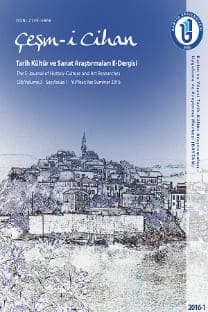MODERN TİYATROYA YANSIYAN MASAL DÜNYASI: NECİP FAZIL KISAKÜREK’İN SABIR TAŞI PİYESİ VE AXEL OLRİC’İN EPİK KURALLARI
Sözlü anlatı geleneğimiz içinde yer alan masallar, nesiller boyunca aktarılarak gelmektedir. Bu aktarımda kültürel bellek önemli bir rol oynamaktadır. Bünyesinde evrensel mesajlar taşıyan masallar, günümüz dünyasının sanatçısının da kültürel belleğinden, vermek istediği mesaj dolayısıyla eserine yansıyabilmektedir. Bu anlamda Necip Fazıl Kısakürek’in Sabır Taşı piyesi, ana hatlarını eski bir Türk masalından alması dolayısıyla anlatı dünyasının masalının modern tiyatro sahnesine taşındığını gösteren bir örnektir. Tiyatro sahnesine taşınan masalda, imgelerden oluşan “gösterilen”lerin tiyatro sahnesinde simge olan “gösterge”ye dönüştüğü görülmektedir.
Bu çalışmanın asıl konusunu, ana hatlarını eski bir Türk masalından alan Sabır Taşı piyesinin anlatı dünyasının kurallarını taşıyıp taşımadığı veya ne derecede taşıdığının tespit edilmesi oluşturmaktadır. Bu yüzden piyes, Axel Olric’in geniş bir biçimde “sage” adını verdiği ve bütün anlatılara uygulanabileceğini söylediği epik kurallar doğrultusunda incelenmiştir. Piyesin masal biyolojisi taşıyıp taşımadığı tespit edilmiştir. Yapılan incelemeye göre modern tiyatronun bir ürünü olan Sabır Taşı piyesi, Axel Olric’in tespit ettiği epik kuralların çoğunluğuna uymakta fakat “bir sahnede iki kuralı” ve “ilk ve son durumun önemi” kurallarına uymamaktadır.
Anahtar Kelimeler:
Necip Fazıl Kısakürek, Sabır Taşı, Axel Olric, Epik Kurallar, Masal, Modern Tiyatro
PROPHET MOHAMMAD AND CALIPH ALI IN THE “DEDE QORQUT RUMOR” COLLECTED IN ZANJAN
The information about Dede Qorqut, who is accepted as the narrator of the Dede Qorqut Epics, is included both in his narrations in the introduction section of the Book of Dede Qorqut and in some historical sources and oral narrations. One of the oral narrations is the “Dede Qorqut Rumor” compiled from Âşık Ferruh Bayat, who lives in the city of Zanjan, Iran today. In the first part of this rumor, which consists of 4 parts, various features of Dede Qorqut such as being a nebi (prophet) or dervish and having a say over the Turks are mentioned. In the second part, it is explained that Dede Qorqut went to Mecca and met with Prophet Mohammad and became a Muslim, and after learning the methods of Islam, he returned to Azerbaijan and conveyed Islam to the Turks. The third part includes the interpretation of why Ali was not given the caliphate, which he claims after Prophet Mohammad's death. In the last part, after the caliphate was not given to Ali, it includes Dede Qorqut's defense of his right to the caliphate, with the poems he read and the epics he told, making a qopuz. While some of the information about Dede Qorqut mentioned in the narration are similar to those in the Book of Dede Qorqut and in historical sources, some of them are not in the mentioned sources. These parts have been shaped by the political and religious structure of Iran. For example, Dede Qorqut's performance of his art to defend Ali's rights can be considered in this context. It is also known that Iranian Turks used Dede Qorqut as a tool in the construction and protection of their national identity. Therefore, this narration, which is important for the construction and protection of national identity apart from the religious and political structure of the region where the text was compiled, has been examined on the basis of these three elements. As a result, we think that this narration, which is compiled from Zanjan and contains Dede Qorqut's meeting with Mohammad, inventing saz (a stringed instrument) and defending Ali in his performances with it, will contribute to Dede Qorqut's studies in terms of containing information about different features of Dede Qorqut.
Keywords:
Prophet Mohammad, Caliph Ali, Narrative, Âşık Ferruh Bayat, Dede Qorqut,
___
- Alangu, T. (1961). Billur Köşk Masalları. İstanbul: Remzi Kitabevi.
- Bastem, N. (2015). Necip Fazıl'ın 'Sabır Taşı' Adlı Tiyatro Eseri ile Billur Köşk Masallarından 'Muradına Eren Dilber' Adlı Masal Üzerine Karşılaştırmalı Bir Çalışma. Turkish Studies, 10(16), 315-330.
- Gümüş, İ. (2018). Türk Masalları ve Max Lüthi Yöntemi. Ankara: Gece Kitaplığı.
- Kısakürek, N. F. (2016). Tiyatro ve Tesiri. İstanbul: Büyük doğu Yayınları.
- Kısakürek, N. F. (2018). Sabır Taşı. İstanbul: Büyük Doğu Yayınları.
- Olric, A. (2006). Halk Anlatılarının Epik Kuralları. Halk Biliminde Kuramlar ve Yaklaşımlar 1 (s. 66-74). içinde Ankara: Geleneksel Yayınları.
- Orta, N. K. (2017, Nisan). Türk Anlatı Geleneğindeki Kahraman Tiplerinin 1980 Sonrası Türk Sinemasındaki Yolculuğu. Doktora Tezi.
- Özünel, E. Ö. (2017). Masal Mekânında Kadın Olmak Masallarda Toplumsal Cinsiyet ve Mekân İlişkisi. Ankara: Geleneksel Yayıncılık.
- Şen, C. (2017). Körlüğü Zedelemek: Necip Fazıl Kısakürek Tiyatrosu Üzerine Bir İnceleme. Ankara: Gece Kitaplığı.
- Törenek, M. (2016). Necip Fazıl'ın Tasavvufi Oyunları. A.Ü. Türkiyat Araştırmaları Enstitüsü Dergisi(56), 1175-1184.
- Türkçe Sözlük. (2011). Ankara: Türk Dil Kurumu.
- URL-1: 05 28, 2020 tarihinde https://tr.wikipedia.org/wiki/Kültürel_bellek adresinden alındı.
- URL-2: 05 29, 2020 tarihinde https://tr.wikipedia.org/wiki/Gösterge_(iletişim) adresinden alındı.
- ISSN: 2149-5866
- Yayın Aralığı: Yılda 2 Sayı
- Başlangıç: 2014
- Yayıncı: Bartın Üniversitesi
Sayıdaki Diğer Makaleler
TÜRK ULUSUNUN İNŞASI ORTAK TARİH SÖYLEMİ
Orta Çağ İngiltere’sinde Şeriflik Kurumunun Gelişimine Dair Mukayeseli Bir Değerlendirme
Zencan’da Derlenen “Dede Korkut Rivayeti”nde Hz. Muhammet ve Hz. Ali
KASTAMONU YÖRESİNDE LÂKAP VERME GELENEĞİ ÜZERİNE BİR İNCELEME
HAYAL İLE GERÇEK ARASINDA TİMBUKTU İMGESİ
PEYAMİ SAFA’NIN GÜN DOĞUYOR PİYESİNDE ANLATICI VE ANLATIM TEKNİKLERİ
YARATICILIKTA SEZGİSEL SÜRECİ ODAĞINA ALAN BİR SANATÇI; CRYSTAL WAGNER
